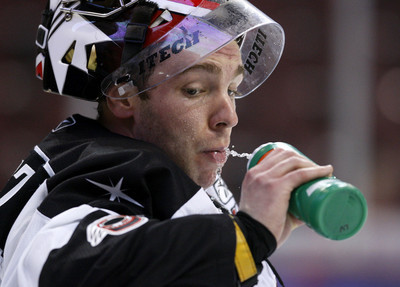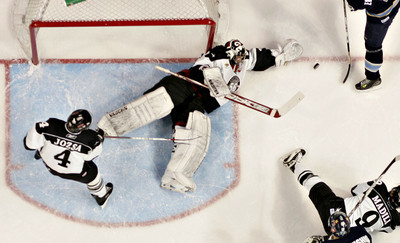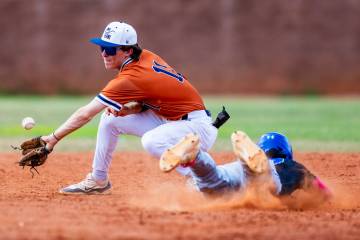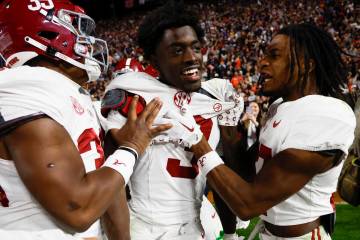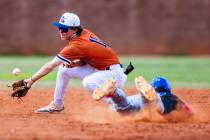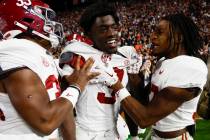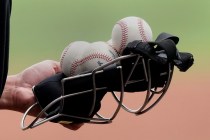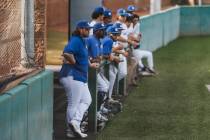Take This Job and Glove It
It takes a special breed of person to voluntarily vie for a job that involves having rock-hard rubber disks fired at all parts of his body at up to 100 mph.
But that's exactly what the position of hockey goaltender entails.
"Everybody thinks it would be scary, but at this point it's the job description," said former Wranglers All-Star goalie Mike McKenna, who is 10-4-1 with the American Hockey League's Portland (Maine) Pirates this season. "You're not worried about the puck hurting, you're worried about getting in front of it and, more often than not, putting the rebound where you want."
Las Vegas netminders Kevin Lalande and Daniel Manzato, who was named to this season's ECHL All-Star Game, agree fear is not a factor when it comes to stopping searing slap shots.
"It's something special. It's part of what drives you to be a goalie, where everything's coming at you," said the 20-year-old Lalande (5-0-2). "When you see something coming at you at 90 mph, your first instinct is to maybe get out of the way or blink your eyes, but as a goalie you can't afford to.
"My job is to stop the puck. If I was scared of the pucks, I'd be doing something else."
Armed with lightweight, state-of-the-art equipment, goalies man the net looking like modern-day gladiators, but pucks inevitably find a way to inflict pain on them.
"It's amazing. Murphy's Law is in full effect for goaltenders," McKenna said. "More often than not, pucks are not going to hurt, but I've got a softball-size welt on the inside of my thigh where I got hit, and I didn't even know I could get hit there.
"If the puck can find somewhere to hit you, it will."
The collarbone area is a difficult place to protect, and goaltenders always are in danger of taking a puck to the head, as McKenna recently discovered the hard way.
"I might get hit in the face once every two or three games, but in the last week I took three direct shots to the face in a row," he said.
The action happens so fast on the ice that goalies barely have time to react, much less think, which Manzato said is a good thing.
"Sometimes if you think too much, you have problems," the 23-year-old rookie from Switzerland said. "The puck arrives so fast and there's so much traffic in front of you, you just have to be focused on the puck and try to stop the puck."
Of course, even when a goalie is doing everything right, things can still go wrong, as Manzato discovered while playing in a PeeWee tournament in Quebec. An opponent fired a shot at him from the blue line that hit the glass behind him, then bounced off his back and into the net.
"It was terrible," he said. "I was 13 years old and a lot of fans in the building were going crazy for us to play there. It was really bad, but that's part of the game."
Lalande recalls tripping onto the ice before a game, and McKenna remembers a game in college he would rather forget.
"The puck was coming at me at 3 mph and I went to poke check it full on and missed it. It went 2 mph under me and into the net," he said. "Everybody has let in some complete clunkers in their lifetime, but ultimately it's how you bounce back from them."
McKenna also takes exception to the stereotype that goalies are quirky and "different" from other players.
"I think we've gotten a bad rap. A couple goalies in the history of the game have made life difficult for everybody," he said. "As great as Patrick Roy was, he used to step over every line on the ice and talk to his goal posts. That doesn't translate well into thinking we're sane people."
Lalande said goalies are a different breed.
"If you're crazy enough to stand in front of a 90 mph shot, you're going to be a little different than the others," he said.
Contact reporter Todd Dewey at tdewey@reviewjournal.com or 383-0354.
FRESNO -- 2 LAS VEGAS -- 1 KEY: The Wranglers suffered their third straight overtime loss to the Falcons when Tyler Kindle scored an unassisted goal from the top of the left circle with 2:19 left in the extra session. NEXT: Victoria at Las Vegas, 7:05 p.m. Friday



